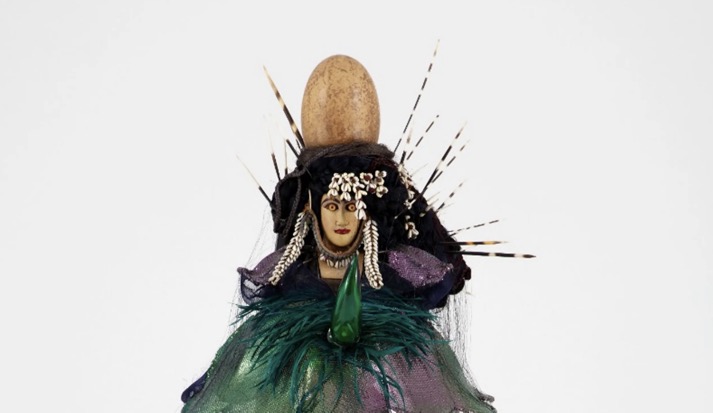Donald Trump attacks the Smithsonian Institution!

Rina Banerjee, In Mute Witness.
One of the works shown in the exhibition The Shape of Power.
Now Trump is accusing this venerable institution of being "subjected to ideological indoctrination or divisive narratives that distort our shared history." The Smithsonian American Art Museum, the Smithsonian Modern Art Museum and the National Museum of African American History and Culture are particularly targeted. Trump accuses them of promoting "narratives that portray American and Western values as inherently harmful and oppressive".
We know that Donald Trump claims as his personal hero and source of inspiration Andrew Jackson (1767-1845), the seventh President of the United States, whose portrait he had hung in the Oval Office as soon as he was elected. Jackson was a white supremacist, a slave-owner who ordered the extermination of entire Indigenous villages. He is famous for having signed, on 6 December 1830, the infamous Indian Removal Act, which allowed the brutal concentration in forts and camps, then the deportation west of the Mississippi, of around 18,000 people from several tribes. At least 4,000 of them died on the "Trail of Tears".
In response to his detractors, Jackson replied that there was no need to feel sorry for these "aborigines" because, in the past, they themselves had exterminated the first inhabitants of the continent, whose past existence was — according to him — proven by archaeology. At the time, the burial mounds and geoglyphs of North America were generally attributed to a powerful civilisation, the Mound Builders, who had been exterminated by the "savages". It was therefore right to fight them, and even to annihilate them. For Jackson, "true philanthropy" consisted in deporting them in order to return the American lands to the descendants of their rightful owners: the colonists, thus allowing the latter to regain their former splendour. This was a foreshadowing of Trump's MAGA (Make America Great Again), which justifies the current president's admiration for his predecessor.
In 1889, the archaeologist Cyrus Thomas wrote in The problem of the Ohio Mounds, that the North American mounds were built by "a people long since extinct or driven from the country, who had attained a culture status much in advance of that reached by the aborigines inhabiting the country at the time of its discovery by Europeans." To support this thesis, he carried out excavations over a period of ten years, the results of which he published in 1894 in the twelfth annual report of the Bureau of Ethnology, published by the Smithsonian Institution. With exceptional intellectual honesty, Cyrus Thomas revealed that his excavations had led him to refute his own opinions, and he concluded his report by asserting that in reality, these remains were not at all due to an ancient superior "race" wiped out by the Indians, but "to the ancestors of the Indians of that section, especially as they are the only pre-Columbian inhabitants of that region of which we have any knowledge." Since then, the scientific conversation has continued, reconstructing the long history of the settlement of America, and finally revealing the utterly mythological — and in no way historical — nature of the racial version of this history, constructed and disseminated by white supremacists.
And yet, on 27 March 2025, the current President of the United States published an edict entitled Restoring Truth and Reason to American History, which reads as follows:
"Once widely respected as a symbol of American excellence and a global icon of cultural achievement, the Smithsonian Institution has, in recent years, come under the influence of a divisive, race-centered ideology. This shift has promoted narratives that portray American and Western values as inherently harmful and oppressive. For example, the Smithsonian American Art Museum today features 'The Shape of Power: Stories of Race and American Sculpture,' an exhibit representing that 'societies including the United States have used race to establish and maintain systems of power, privilege, and disenfranchisement.' The exhibit further claims that 'sculpture has been a powerful tool in promoting scientific racism' and promotes the view that race is not a biological reality but a social construct, stating 'Race is a human invention.' "
Trump goes on to say that "Museums in our Nation’s capital should be places where individuals go to learn — not to be subjected to ideological indoctrination or divisive narratives that distort our shared history. To advance this policy, we will restore the Smithsonian Institution to its rightful place as a symbol of inspiration and American greatness — igniting the imagination of young minds, honoring the richness of American history and innovation, and instilling pride in the hearts of all Americans […] The Vice President and the Director of the Office of Management and Budget shall work with the Congress to ensure that future appropriations to the Smithsonian Institution prohibit expenditure on exhibits or programs that degrade shared American values, divide Americans based on race, or promote programs or ideologies inconsistent with Federal law and policy."
So the current President intends to "remove" the "improper ideology" that, in his view, is blighting the institution. However, far from being an "improper ideology", it is the expression of the current scientific consensus, developed following a long international scientific conversation, in which the Smithsonian Institution has played a major role. As anthropologists and archaeologists, we felt it was important to re-establish these elements of historical truth and to affirm our support for the Smithsonian Institution and our solidarity with our colleagues who have been brutally attacked.
Jean-Loïc Le Quellec and Nicolas Teyssandier

